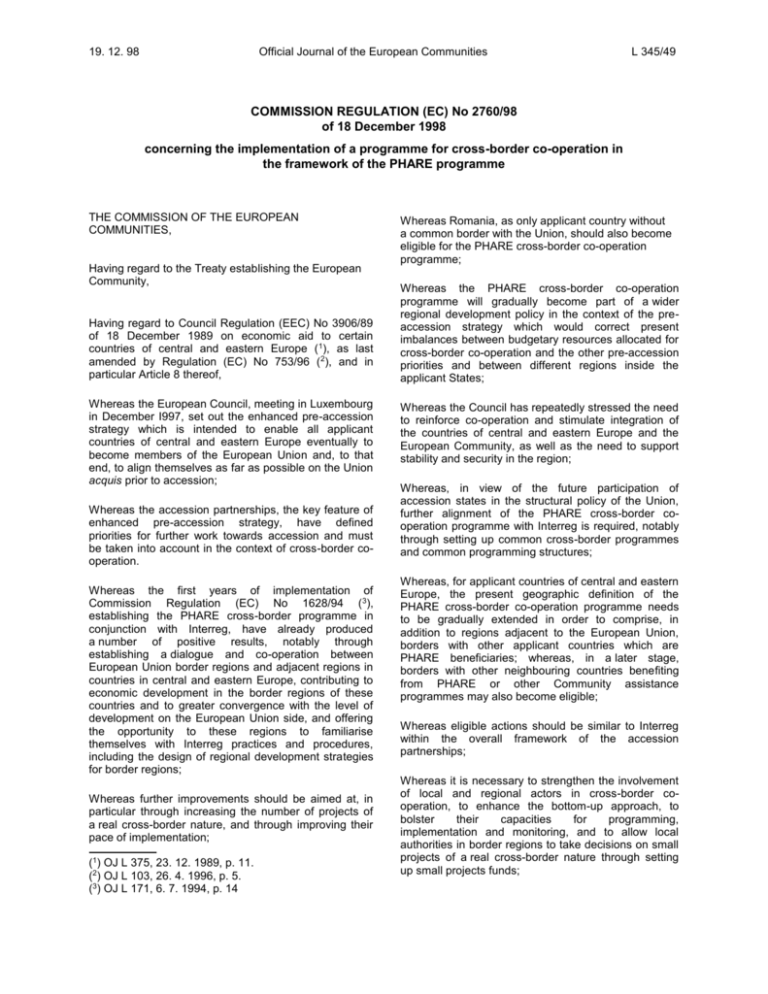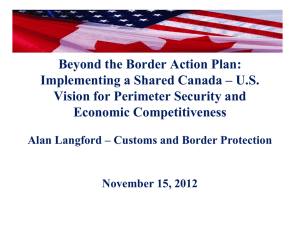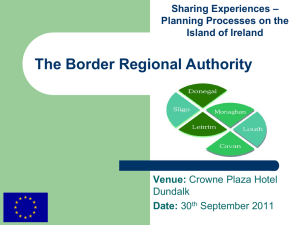cbc regulation
advertisement

19. 12. 98 Official Journal of the European Communities L 345/49 COMMISSION REGULATION (EC) No 2760/98 of 18 December 1998 concerning the implementation of a programme for cross-border co-operation in the framework of the PHARE programme THE COMMISSION OF THE EUROPEAN COMMUNITIES, Having regard to the Treaty establishing the European Community, Having regard to Council Regulation (EEC) No 3906/89 of 18 December 1989 on economic aid to certain countries of central and eastern Europe ( 1), as last amended by Regulation (EC) No 753/96 (2), and in particular Article 8 thereof, Whereas the European Council, meeting in Luxembourg in December I997, set out the enhanced pre-accession strategy which is intended to enable all applicant countries of central and eastern Europe eventually to become members of the European Union and, to that end, to align themselves as far as possible on the Union acquis prior to accession; Whereas the accession partnerships, the key feature of enhanced pre-accession strategy, have defined priorities for further work towards accession and must be taken into account in the context of cross-border cooperation. Whereas the first years of implementation of Commission Regulation (EC) No 1628/94 (3), establishing the PHARE cross-border programme in conjunction with Interreg, have already produced a number of positive results, notably through establishing a dialogue and co-operation between European Union border regions and adjacent regions in countries in central and eastern Europe, contributing to economic development in the border regions of these countries and to greater convergence with the level of development on the European Union side, and offering the opportunity to these regions to familiarise themselves with Interreg practices and procedures, including the design of regional development strategies for border regions; Whereas further improvements should be aimed at, in particular through increasing the number of projects of a real cross-border nature, and through improving their pace of implementation; (1) OJ L 375, 23. 12. 1989, p. 11. (2) OJ L 103, 26. 4. 1996, p. 5. (3) OJ L 171, 6. 7. 1994, p. 14 Whereas Romania, as only applicant country without a common border with the Union, should also become eligible for the PHARE cross-border co-operation programme; Whereas the PHARE cross-border co-operation programme will gradually become part of a wider regional development policy in the context of the preaccession strategy which would correct present imbalances between budgetary resources allocated for cross-border co-operation and the other pre-accession priorities and between different regions inside the applicant States; Whereas the Council has repeatedly stressed the need to reinforce co-operation and stimulate integration of the countries of central and eastern Europe and the European Community, as well as the need to support stability and security in the region; Whereas, in view of the future participation of accession states in the structural policy of the Union, further alignment of the PHARE cross-border cooperation programme with Interreg is required, notably through setting up common cross-border programmes and common programming structures; Whereas, for applicant countries of central and eastern Europe, the present geographic definition of the PHARE cross-border co-operation programme needs to be gradually extended in order to comprise, in addition to regions adjacent to the European Union, borders with other applicant countries which are PHARE beneficiaries; whereas, in a later stage, borders with other neighbouring countries benefiting from PHARE or other Community assistance programmes may also become eligible; Whereas eligible actions should be similar to Interreg within the overall framework of the accession partnerships; Whereas it is necessary to strengthen the involvement of local and regional actors in cross-border cooperation, to enhance the bottom-up approach, to bolster their capacities for programming, implementation and monitoring, and to allow local authorities in border regions to take decisions on small projects of a real cross-border nature through setting up small projects funds; L 345/50 Official Journal of the European Communities Whereas it is necessary to replace Regulation (EC) No 1628/94; (ii) Whereas the present Regulation is in accordance with the opinion of the Committee for Economic Restructuring in certain countries of central and eastern Europe HAS ADOPTED THIS REGULATION: Article 1 Within the overall framework of the PHARE programme as defined by Regulation (EEC) No 3906/89, the following rules apply for financing actions of a structural nature in border regions of countries of central and eastern Europe, which are PHARE beneficiaries. These actions will be implemented taking into account the Community structural policies, and Interreg in particular. Article 2 1. The eligible borders are those between the countries of central and eastern Europe and the Community, and those between the following applicant countries: Bulgaria, Czech Republic, Estonia, Hungary, Latvia, Lithuania, Poland, Romania, Slovakia and Slovenia. 19. 12. 98 to promote the creation and the development of co-operation networks on either side of the border, and the establishment of links between these networks and wider Community networks. Article 4 1. In the border regions selected according to Article 2 the projects to be included in the cross-border cooperation programme can take the form of: (i) (ii) projects linked with measures that are supported by Interreg or by other Community external assistance programmes; projects agreed by the countries concerned, that have a cross-border impact, contribute to the development of structures in border regions and facilitate co-operation between the countries as a whole. 2. Special attention will be given to projects in relation to which co-financing by, or on behalf of, the local authorities or economic operators in the countries of central and eastern Europe is provided. 3. Financing may include resources from other Member States of the European Union and countries of central and eastern Europe, from international financial institutions, and from other private and public sources. Article 5 2. The border regions concerned will be fixed by each country concerned in agreement with the Commission, taking into account the methodology adopted for Interreg. 1. The actions that can be financed under this programme could include: (a) alleviation of administrative and institutional obstacles to the free flow of persons, products or services across the border while taking into account the security aspects of such flows; (b) improving infrastructures, in particular communication facilities and the provision of local water, gas and electricity supplies, providing benefits across border areas; (c) environmental protection, for instance waste management, environmental management and pollution prevention dealing with problems exacerbated by the proximity to external borders; (d) agricultural and rural development measures with particular attention for facilitating cross-border cooperation projects; (e) measures in the fields of energy and transport, aimed at complementing the development of trans-European networks in accordance with the orientations adopted by the Commission; 3. Allocations between beneficiary countries shall be made taking into account criteria of population, GDP per capita and surface of the border regions concerned. Article 3 Community grants under this programme will primarily finance the participation of the country of central and eastern Europe concerned in joint projects with each state with which it shares a common border as defined in Article 2. The aims of these projects are: (i) to promote co-operation of border regions in countries in central and eastern Europe with adjacent regions in a neighbouring countries defined in Article 1 and thus to help the border regions in central and eastern Europe to overcome the specific development problems which may arise, inter alia, from their position within the national economies , in the interest of the local population and in a manner compatible with the protection of the environment; 19. 12. 98 (f) Official Journal of the European Communities actions related to justice and home affairs Community policy; (g) promotion of business co-operation, enterprise development, financial co-operation and cooperation between institutions representing the business sector (e.g. chambers of commerce); (h) aid to investment and provision of supporting services and facilities, in particular for technology transfer and for marketing for small and mediusized enterprises; (i) training and employment measures; (j) local economic development, including tourism; (k) measures to promote co-operation in health, particularly the sharing of resources and facilities on a cross-border basis; (l) the development or establishment of facilities and resources to improve the flow of information and communications between border regions, including support for cross-border radio, television, newspapers and other media; local employment, initiatives. Article 6 1. The Community contribution is provided in principle as a grant. However, whenever the Community grant contributes to the financing of revenue-generating activities, the Commission shall determine, in consultation with the authorities involved, the rules for financing which may include co-financing by the project’s revenues or reimbursement of the initial grants. 2. The aid may cover expenditures on imports and local expenditure needed to carry out the projects and programmes. Tax duties and charges and the purchase of property shall be excluded from the Community financing. 3. Costs covered may include technical assistance, studies, training and other institution-building measures; supply programmes for essential equipment or inputs; investment operations, including work programmes. 4. Maintenance and operating costs in central and eastern European countries may be covered in the start-up phase and in digressive manner. (m) cultural exchanges; (n) L 345/51 education and training However, actions mentioned under (j) to (n) may only be financed under the terms of Article 5 (2) below. 2. With a view to encouraging joint small scale actions involving local actors from the other border regions and to enhancing their capabilities to identify, develop and implement such actions, a joint small project fund may be established in each border region, for which a limited percentage of the appropriations for the relevant programmes and initiatives for cross-border cooperation may be used; 3. Special attention will be given to measures with a strong cross–border co-operation character which are planned in close co-operation with the regional and local authorities in border areas and which include the establishment or development of shared management structures intended to widen and deepen cross-border co-operation between public and para-public agencies as well as non-profit organisations. 4. The establishment of plans for the development of border regions, project identification and programme formulation, feasibility studies, assistance for the implementation of the programmes and monitoring and/or evaluation studies, may also be financed. Article 7 1. For each of the border regions, a Joint Co-operation Committee will be set up consisting of representatives of the countries concerned, including regional or local representatives, and of representatives of the Commission. 2. The Joint Co-operation Committee will prepare a joint cross-border programming document in a multiannual perspective: this document will include common development strategies and priorities of the region, seen as one single socio-economic and geographical entity, and provisions concerning joint implementation. This document will guide the programming and implementation of the actions to be undertaken in the framework of the relevant programmes and initiatives for cross-border co-operation, assisted by the European Community. 3. The Joint Co-operation Committee will define a common set of projects once per year, taking into account the joint cross-border programming document provided under paragraph 2. Recommendations for projects will be transmitted to the Commission by the Government of the country of central and eastern Europe concerned on the basis of the proposals submitted by the relevant authorities. L 345/52 Official Journal of the European Communities Article 8 1. The Commission will formulate a programme proposal per border taking into account the joint crossborder programming document referred to under Article 7 (1) and further recommendations of the Joint Cooperation Committee for projects to be financed under this programme, as transmitted by the government of the central and eastern European country concerned. 2. The grant constituting the full or partial contribution of the country of central and eastern Europe to the joint project will be approved following the procedure defined in Article 9 of Regulation (EEC) No 3906/89 and agreed with the recipient country concerned by means of a financing memorandum. 19. 12. 98 assistance to central and eastern Europe, as defined in Regulation (EEC) No 3906/89. 2. Wherever possible, joint monitoring structures should be set up to facilitate the implementation of the programmes. Article 10 In implementing the objectives referred to pursuant to Article 3, the Commission shall ensure co-ordination and consistency between assistance from PHARE, other external assistance programmes, and assistance provided by the Structural Funds. Article 11 Article 9 1. The Commission shall administer their assistance in accordance with the normal practise applied to the This Regulation shall enter into force on the third day following its publication in the Official Journal of the European Communities, and shall replace Regulation (EC) No 1628/94 on that day. This Regulation shall be binding in its entirety and directly applicable in all Member States. Done at Brussels, 18 December 1998. For the Commission Hans VAN DEN BROEK Member of the Commission







